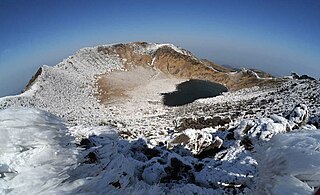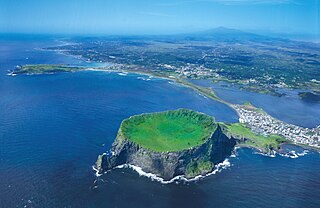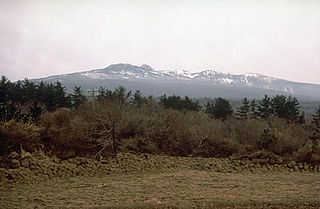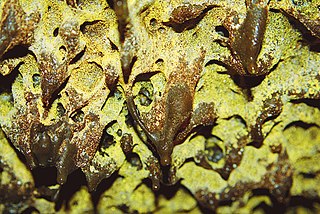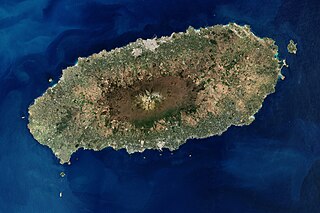| Gimnyeonggul | |
| Hangul | 김녕굴 |
|---|---|
| Hanja | 金 寧 窟 |
| Revised Romanization | Gimnyeonggul |
| McCune–Reischauer | Kimyŏnggul |
The Gimnyeonggul Lava Tube , located in Donggimnyeong-ri, Gujwa-eup, Jeju City, is one of the World Heritage Sites in South Korea.

A lava tube is a natural conduit formed by flowing lava which moves beneath the hardened surface of a lava flow. Tubes can drain lava from a volcano during an eruption, or can be extinct, meaning the lava flow has ceased, and the rock has cooled and left a long cave.

Jeju is the capital of Jeju Province in South Korea and the largest city on Jeju Island. The city is served by Jeju International Airport.
Contents
The lava tube is about 705 m long, and is believed to be separated from Manjanggul Lava Tube by lava flows. The upper part of entrance is 12 m high and 4 m wide and is bent in a collapsed S shape. The upstream end of the passage was sealed with subsequent lava flows. The downstream passage is bi-level and the entrance is filled with sediments, most of which are carbonate sediments that had flown in from the beach. This is understood to be why there are lime features.

The Manjanggul Lava Tube is located in Gimnyeong-ri, Gujwaeup, Jeju City. At up to 23m wide, 30m high and 8.928km long, it is the 12th-longest lava tube in the world and the second longest on Jeju island. It is regarded as having significant scientific and heritage value, owing to its excellent condition of preservation despite its age of formation.
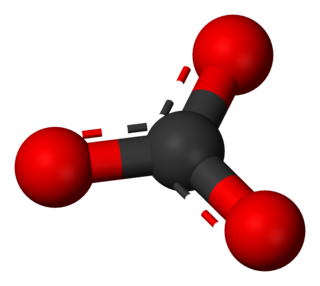
In chemistry, a carbonate is a salt of carbonic acid (H2CO3), characterized by the presence of the carbonate ion, a polyatomic ion with the formula of CO2−
3. The name may also refer to a carbonate ester, an organic compound containing the carbonate group C(=O)(O–)2.
The upstream end part is covered by a rich natural forest and the other end is covered with sand dunes. There is a significant amount of sand inside the tube. Because very little organic material has infiltrated the tube, Gimnyeonggul does not offer favorable habitats for cave life. Around 20 species are living in tube.

In physical geography, a dune is a hill of loose sand built by aeolian processes (wind) or the flow of water. Dunes occur in different shapes and sizes, formed by interaction with the flow of air or water. Most kinds of dunes are longer on the stoss (upflow) side, where the sand is pushed up the dune, and have a shorter "slip face" in the lee side. The valley or trough between dunes is called a slack. A "dune field" or erg is an area covered by extensive dunes.
The Gimnyeong lava tube is also called "Gimnyeongsagul" or "Sagul (Snake Cave)", a name originating in ancient history. According to a legend, there was a big snake living in the cave, and the snakes demanded the yearly sacrifice of a girl. If people didn’t make that offering to it, it caused natural disasters such as typhoons. A judge Mr. Lin Seo killed the snake in 1515. After that event, the legend states, the village was able to be in peace. By the entrance of the cave, a monument was established speaking highly of Mr. Lin Seo.

A typhoon is a mature tropical cyclone that develops between 180° and 100°E in the Northern Hemisphere. This region is referred to as the Northwestern Pacific Basin, and is the most active tropical cyclone basin on Earth, accounting for almost one-third of the world's annual tropical cyclones. For organizational purposes, the northern Pacific Ocean is divided into three regions: the eastern, central, and western. The Regional Specialized Meteorological Center (RSMC) for tropical cyclone forecasts is in Japan, with other tropical cyclone warning centers for the northwest Pacific in Hawaii, the Philippines and Hong Kong. While the RSMC names each system, the main name list itself is coordinated among 18 countries that have territories threatened by typhoons each year A hurricane is a storm that occurs in the Atlantic Ocean or the northeastern Pacific Ocean, a typhoon occurs in the northwestern Pacific Ocean, and a tropical cyclone occurs in the South Pacific or the Indian Ocean.
